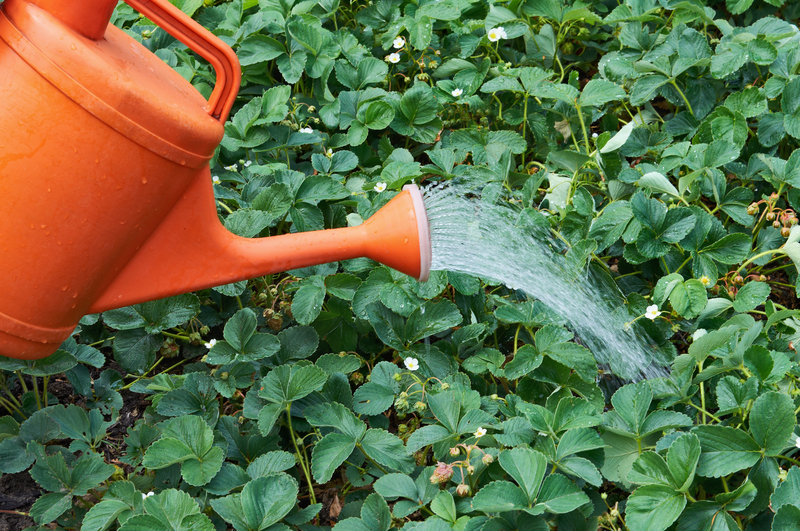Transform Dim Corners with Evergreen Shade Climbers
Posted on 12/09/2025
Transform Dim Corners with Evergreen Shade Climbers: Breathe Life Into Shady Spaces
Shady and dim corners of gardens or patios are often challenging to design, frequently overlooked and left barren. However, transforming dim corners with evergreen shade climbers is an artful solution that not only fills these forgotten spaces with verdant charm but also ensures year-round interest. If you've struggled with sparse foliage or lifeless patches where the sun rarely shines, allow us to introduce you to the ultimate solution--evergreen climbers for shade. With the right selection and care, your dim corners can be turned into enchanting, lush havens.

Why Choose Evergreen Shade Climbers for Dim Corners?
Planting evergreen climbers in shaded corners is a game-changer for spaces that receive little sun. Unlike their deciduous cousins, evergreen vines for shade maintain their foliage and continue to decorate your garden with color and texture throughout the year. Here's why they stand out:
- All-year coverage: Permanent, dense foliage even through winter months.
- Wildlife support: Evergreen climbers offer vital shelter and food for birds and beneficial insects.
- Low maintenance: Suitable varieties thrive in shade with minimal intervention.
- Structural interest: They soften hard lines, mask eyesores, and lift vertical spaces, adding both depth and personality to your garden.
- Versatility: Grow over trellises, fences, walls, pergolas, or as groundcover in tough spots.
The Best Evergreen Shade Climbers to Transform Your Dim Corners
Let's explore a curated list of shade tolerant evergreen climbers that will add character and greenery to even the gloomiest corners.
1. Climbing Hydrangea (Hydrangea anomala subsp. petiolaris)
Climbing hydrangea is renowned for its ability to thrive in deep shade, making it a reliable favorite for difficult garden spots. This evergreen climber for dark corners produces elegant, white lace-cap flowers in early summer, complemented by leathery, rich green leaves that create attractive coverage even in winter. Its aerial roots latch firmly to walls or tree trunks for effortless vertical greening.
- Light: Part to full shade
- Soil: Moist, well-drained - tolerates clay
- Flower: Showy white from late spring to summer
- Interest: Winter bark is beautifully exfoliating
2. Ivy (Hedera helix and H. colchica)
Few plants rival the resilience of ivy as an evergreen shade vine. Its classic, lobed leaves provide dense, evergreen cover and can climb almost any surface. Ivy's ability to withstand deep shade, drought once established, and urban pollution make it ideal for city gardens and awkward corners.
- Light: From heavy shade to full sun
- Soil: Almost any except waterlogged
- Maintenance: Trim regularly to curb invasiveness
- Interest: Supports pollinators and nesting birds
3. Star Jasmine (Trachelospermum jasminoides)
While it prefers dappled shade, star jasmine is one of the most rewarding evergreen climbers for shaded spots. Its glossy, dark green leaves and intensely fragrant, star-shaped, white blooms offer a striking impact. This climber is excellent against shady walls or pergolas, and its winter foliage can bronze in colder months, adding further visual interest.
- Light: Partial shade ideal
- Scent: Powerful, sweet fragrance in summer
- Use: Trellis, fence, containers
4. Japanese Honeysuckle (Lonicera japonica 'Halliana')
This vigorous evergreen honeysuckle for shade retains much of its foliage year-round in milder climates. It is beloved for its dual tones of white and yellow trumpets that emerge from spring to autumn, exuding a gentle, sweet scent. Japanese Honeysuckle works beautifully in woodland gardens or for cloaking shady fences with wildlife-friendly abundance.
- Light: Partial to full shade
- Attracts: Bees, butterflies, and birds
- Spread: Vigorous - provide support and prune after flowering
5. Wintercreeper (Euonymus fortunei)
This versatile, low-growing climber can scale walls or serve as groundcover. Wintercreeper Euonymus remains evergreen while tolerating deep shade and a range of soils. Choose from several variegated varieties for added brightness in the darkest corners.
- Light: Shade to sun
- Features: Versatile as both climber and creeper
- Foliage: Variegated options for color
6. Clematis Armandii
Clematis are famously sun-loving, but the Clematis armandii variety is a rare shade tolerant evergreen flowering climber. Its long, leathery, dark green leaves reliably cloak fences and walls, while fragrant white flowers appear in early spring.
- Light: Thrives in light shade
- Flower time: Early spring
- Special trait: Scented blooms
How to Successfully Grow Evergreen Shade Climbers
Selecting the best evergreen vines for shady areas is just the first step. Follow these simply essential tips to help them truly thrive and rejuvenate your dim corners:
1. Choose the Right Plant for Your Conditions
Assess your light levels and soil moisture throughout the year. Some shade may be dry under trees, while walls often create cool, moist pockets. Since not all shade is alike, always tailor your choice to the precise requirements--whether deep shade evergreen climbers or those happy in partial shade.
2. Prepare the Planting Site
Break up compacted soil and enrich it with organic matter or compost. If your corner is particularly dry (such as under mature trees or building eaves), incorporate moisture-retaining materials and mulch well after planting. This ensures roots stay cool and moist, mimicking a woodland environment.
- Loosen soil at least 50cm (20 in) deep for strong root growth
- Mix in organic matter: Compost or leaf mold improves structure and fertility
- Mulch: Use leaf mold, bark, or well-rotted manure to lock in moisture
3. Provide Effective Support
Many evergreen climbing plants for shade need something to cling to. Install a trellis, galvanised wires, or a decorative obelisk before planting. This saves disturbing roots later while helping the vine rise more quickly and fill out your shaded nook.
4. Water and Feed Regularly (Especially Establishment Year)
Although many evergreen climbers are drought-tolerant once mature, shaded spots tend to dry out slowly. After planting, water deeply and often to encourage deep rooting. A balanced, slow-release fertilizer in spring helps maintain healthy, lush foliage.
5. Prune and Train for Shape
Pruning helps climbers stay within bounds and allows light to penetrate for even growth. Remove deadwood and shape new growth regularly, especially with vigorous species like ivy and honeysuckle. Tie in wandering stems as needed to train the plant into any blank spaces.
Creative Uses for Evergreen Climbers in Shade
The benefits of evergreen shade climbers extend beyond simply filling awkward spaces. Use them for vertical greening, screening, or to create lush, serene retreats. Here are some inspiring ideas:
- Green Privacy Screens: Use on fences, pergolas or between patios for living privacy walls
- Disguise Unsightly Areas: Cloak sheds, old garages, or bins with lush foliage
- Frame Entrances: Train climbers to arch over gates and garden doors for a welcoming effect
- Wildlife Corridors: Connect habitats by growing climbers between trees and structures
- Understory Layer: Pair with shade perennials, ferns, and hostas for a layered, woodland look
Enhancing Dim Corners: Design Tips and Tricks
For truly transforming dim corners with evergreen climbers, integrate design techniques that maximize their beauty:
- Layering: Plant climbers alongside shade-loving shrubs or groundcovers for a natural, abundant look.
- Mix Textures: Combine glossy-leaved star jasmine with matte-finish hydrangeas for visual contrast.
- Add Color Accents: Choose variegated or bronze-tinted varieties to reflect light and brighten dark spaces.
- Feature Focal Points: Grow evergreen climbers around a sculpture, bench, or water feature to draw the eye.
Common Problems and Solutions When Growing Evergreen Shade Climbers
Even for resilient climbers, shade presents specific challenges. Here's how to address the most frequent issues:
- Leggy growth: Insufficient light can make some climbers sparse. Prune to promote bushiness and choose varieties suited for deep shade.
- Poor flowering: Many climbers need a bit of sun for blooms. Prioritize foliage interest if growing in heavy shade, or place in dappled rather than full shade.
- Pests and diseases: Damp, stagnant air encourages fungal problems. Space plants for good air movement, and remove any affected foliage promptly.
- Drought stress: Surprisingly, shaded soil can dry out, especially under trees. Deep mulch and regular watering help prevent dehydration.

Frequently Asked Questions About Evergreen Shade Climbers
What is the fastest-growing evergreen climber for shade?
English ivy (Hedera helix) and wintercreeper euonymus are among the quickest options, delivering speedy coverage even in challenging spots.
Do evergreen climbers need pruning?
Yes! Regular pruning keeps growth compact, encourages fullness, and prevents overly aggressive species from becoming invasive. Always prune after flowering or in late winter for best results.
Can evergreen climbers grow indoors?
Many shade-tolerant climbers, such as certain ivies, can be grown indoors with adequate indirect light and humidity. Try potted versions on stairways or in sunrooms for indoor greening.
Can I grow evergreen climbing plants on north-facing walls?
Absolutely! North-facing walls are ideal for shade tolerant evergreen climbers like hydrangeas, ivy, and star jasmine.
Conclusion: Elevate Dim Corners with Evergreen Shade Climbers
*Dim and forgotten corners need not stay dreary. By choosing evergreen shade-loving climbers, you bring texture, life, and year-round interest to the most challenging spaces. Whether cloaking a shaded wall in glossy foliage, introducing fragrant blooms to a woodland garden, or creating year-round privacy, these remarkable plants promise lasting garden transformation. With proper planning, preparation, and a touch of design inspiration, your shaded corners can become the most magical part of your outdoor sanctuary.*
Start planning today and turn dim corners into standout features with evergreen climbers for shade--nature's artful solution for lush, beautiful gardens.

